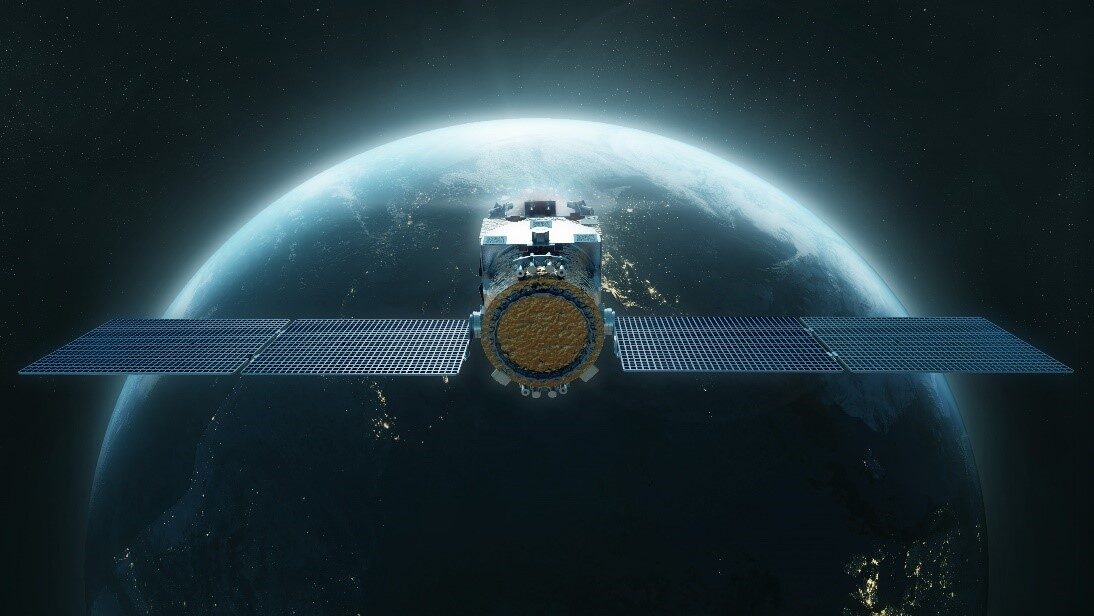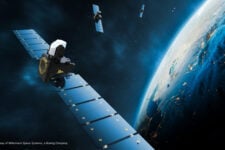
Astroscale US is building a prototype satellites for refueling other satellites on orbit under a Space Force contract worth $25.5M. (Graphic: Astroscale US)
ORLANDO — In the near term, the Space Force’s plans to implement dynamic space operations are focused on acquiring satellites that can be refueled and the means to do so, as well as propulsion units that can be strapped on to satellites that have run out of fuel, according to service officials.
“We’re taking our cues from Space Systems Command,” Brig. Gen. Kristin Panzenhagen, Space Force program executive officer for Assured Access to Space, told reporters here today. “So that’s where prioritizing on-orbit refueling is coming from as the immediate need. You know, everybody’s focused on great power competition and making sure that we as a force are prepared to meet that.”
The Assured Access to Space office is the acquisition unit not just space mobility and logistics, but also for the Space Force’s launch programs.
In addition, Panzenhagen said, to fill “the immediate demand signal,” the service is looking at acquiring “a backpack or a jetpack that could go connect up with an existing satellite to give it more propulsion, whether it’s not designed to have sufficient thrust or it’s out of propellant.”
Col. Joyce Bulson, who heads Space System Command’s new(ish) Servicing, Mobility and Logistics Office, explained that her office just stood up in September to “answer those demands from US Space Command as well as our other mission partner partners,” including Indo-Pacific and Transportation Commands.
She said that since mobility and logistics was tagged as a “core mission area” for the Space Force in 2020, there have been lots of discussions, formal requirements generated and a number of early research programs launched by various Defense Department agencies, such as the Defense Innovation Unit and Air Force Research Laboratory.
“All of these technologies and things we’re looking at are based on what others have already started doing,” she said, stressing that “we are not trying to duplicate the efforts that are being done.”
For example, Bulson said, “we are heavily dependent from a future servicing, mobility and logistics perspective on … NASA and DARPA making progress on both OSAM and RSGS [Robotic Servicing of Geosynchronous Satellites].”
“So, it’s definitely a community of all of us coming together with these great activities and projects that have been started, but putting that together into a roadmap so that our efforts are aligned from what we’ve seen with our past engagements with our partners,” Bulson said.
More specifically, since her office stood up, Bulson said she has been “going out to our stakeholders and our leadership and understanding what they very specifically were looking for, because we do have a number of requirements documents and they are fairly broad scope.”
With regard to mobility — that is, the ability for spacecraft to maneuver on orbit with (relative) speed and over long durations — she said the Space Force has found that “the easiest piece for us to get at is refueling for prepared clients,” along with solutions such as the backpack concept for spacecraft that are “unprepared” to be refueled.
For example, besides Northrop Grumman’s Passive Refueling Module (PRM) that has just been certified by the Space Force as one “preferred” standard design to equip new satellites for refueling, Bulson said that the Space Force also “other refueling ports that we’re looking at and that we have on contract.” Northrop Grumman’s was just the first to go through the process, she explained, stressing that her team is “working with other partners to evaluate their designs and figure out what’s the best process to get those under review for the larger Space Force community. However, she did not specify what other companies are involved.
Meanwhile, more challenging, longer term technologies are being pursued by the Space Force’s science and technology-oriented “partners,” Bulson said. Further, she said her team has been working with the Space Warfighting Analysis Center to gear up a force design study to lay out options for the future of the mobility and logistics mission.
Beyond refueling, the program office will “be looking to expand into general servicing capabilities because refueling isn’t the only life limiter for a spacecraft, and not the only thing that can be … targeted from a threat perspective,” Bulson added, with an eye to both “resiliency and life-extension” for satellites.
Asked about the planned DoD budget for dynamic space operations — which both industry and the White House National Space Council have asserted has so far been inadequate — both Bulson and Panzenhagen declined to talk about either the fiscal 2025 budget which already has been put together or the 2026 budget that is now being planned.
Panzenhagen, however, did note that “there’s a constant effort to make sure that we are requesting the funding that we need to do these programs.”
Bulson, for her part, said that “people need to have a realistic expectation of the demand signal,” stressing that the Space Force is “looking to leverage commercial services to the maximum extent possible, so we’re not looking for a significant government investment in bringing these capabilities to bear.”
Panzenhagen was a bit more forthcoming, however, on the big budget elephant at the Pentagon right now: the prospect of a long-term continuing resolution. In particular, she said, as long as there is no congressionally approved FY24 budget, the Space Force cannot exceed the number of launches it undertook in FY23. That number, she said, was three and the service already has a minimum of 10 launches planned for FY24.
The Space Force received $1 billion from Congress in FY23 for its major launch program, the National Security Space Launch program, and requested a whopping $2.1 billion in FY24.
‘The One’: Millennium wins ‘FOO Fighter’ missile defense satellite program
While the Space Development Agency initially intended to make awards to more than one vendor, the agency determined that a sole-source contract with the Boeing-owned firm was “best value.”


























